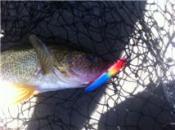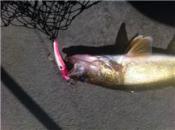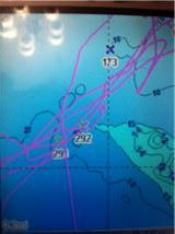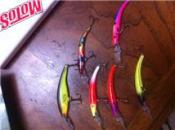 An over abundance of small walleye in a reservoir can be a frustrating ordeal for the angler looking to consistently catch low twenty inch fish, with the occasional one over twenty five inches. Duluth is home to many stained-water reservoirs that contain a plethora of 11 to 15 inch walleyes that are easily catchable on jigs and lindy rigs throughout the summer months. To find a pattern that will target larger fish, one has to drastically change their program and location in order to fulfill their goal and have that opportunity at a once in a lifetime giant.
An over abundance of small walleye in a reservoir can be a frustrating ordeal for the angler looking to consistently catch low twenty inch fish, with the occasional one over twenty five inches. Duluth is home to many stained-water reservoirs that contain a plethora of 11 to 15 inch walleyes that are easily catchable on jigs and lindy rigs throughout the summer months. To find a pattern that will target larger fish, one has to drastically change their program and location in order to fulfill their goal and have that opportunity at a once in a lifetime giant.
 Trolling crankbaits is a technique that has proven itself over and over for producing bigger fish, from the great lakes, to the small not-so-great inland lakes. Believe it or not, this is also the case here as in the past four years I have seen more twenty plus inch fish than ever before. There are a number of reasons why this presentation works and why it consistently puts larger fish in the boat when other anglers struggle to see a seventeen inch fish. First off, larger profile baits will scare off small walleyes to the extent where they will want nothing to do with it. Don’t get me wrong, you will still catch that kamikaze 10 inch walleye that will hit an 800 Reefrunner, but 95% of these fish will avoid it. Secondly, it becomes more and more evident to me that larger fish prefer larger bait. No this is not the case in all circumstances, but in the warm summer months when the water temps are reaching the upper 70’s these fish are all too anxious to eat something large. Furthermore, on lakes like these, larger fish are spread out, which means covering a greater area of water is critical. Just imagine how many better fish see your presentation when you are trolling at 2.2 mph, vs. .5 mph.
Trolling crankbaits is a technique that has proven itself over and over for producing bigger fish, from the great lakes, to the small not-so-great inland lakes. Believe it or not, this is also the case here as in the past four years I have seen more twenty plus inch fish than ever before. There are a number of reasons why this presentation works and why it consistently puts larger fish in the boat when other anglers struggle to see a seventeen inch fish. First off, larger profile baits will scare off small walleyes to the extent where they will want nothing to do with it. Don’t get me wrong, you will still catch that kamikaze 10 inch walleye that will hit an 800 Reefrunner, but 95% of these fish will avoid it. Secondly, it becomes more and more evident to me that larger fish prefer larger bait. No this is not the case in all circumstances, but in the warm summer months when the water temps are reaching the upper 70’s these fish are all too anxious to eat something large. Furthermore, on lakes like these, larger fish are spread out, which means covering a greater area of water is critical. Just imagine how many better fish see your presentation when you are trolling at 2.2 mph, vs. .5 mph.
 I would also like to point out location and how this plays an important role in the ability to effectively and efficiently target these fish. There are two main areas that I like to focus on, and they are large bays with a consistent depth suitable for walleye populations, and shoreline structure adjacent to deep water. Both make for a prime trolling scenario, yet they provide drastically different structure and habitat, and on a day where the fish aren’t going on one of those spots, the other will usually yield fish. In an area with a consistent depth, whether it is a large flat, or a bay, the walleyes will tend to relate to any available structure. A one foot rise in the bottom can spell jackpot when trolling these areas. With the Lakemaster chip, I am able to zoom in and locate these rises in the bottom, whether it is an isolated hump, or an underwater point that extends out from an island. Another thing I have noticed is the commonality of these fish to suspend, and I’m talking six and seven feet off the bottom in twelve to fourteen feet of water. In the latter location mentioned above, the deep water provides prime habitat for these bigger fish to dwell in. Closely following the Lakemaster contours, I like to troll up and down these shorelines that lie next to the deep-main lake basin. The other day, the fish were extremely active in bay which can also be seen as a flat type area that holds a constant depth. They were grouped up in schools that would attack a crankbait at first sight. 80% of this area had no feeding fish, so once we ruled out that water it was one after another, again proving that covering water is the name of the game.
I would also like to point out location and how this plays an important role in the ability to effectively and efficiently target these fish. There are two main areas that I like to focus on, and they are large bays with a consistent depth suitable for walleye populations, and shoreline structure adjacent to deep water. Both make for a prime trolling scenario, yet they provide drastically different structure and habitat, and on a day where the fish aren’t going on one of those spots, the other will usually yield fish. In an area with a consistent depth, whether it is a large flat, or a bay, the walleyes will tend to relate to any available structure. A one foot rise in the bottom can spell jackpot when trolling these areas. With the Lakemaster chip, I am able to zoom in and locate these rises in the bottom, whether it is an isolated hump, or an underwater point that extends out from an island. Another thing I have noticed is the commonality of these fish to suspend, and I’m talking six and seven feet off the bottom in twelve to fourteen feet of water. In the latter location mentioned above, the deep water provides prime habitat for these bigger fish to dwell in. Closely following the Lakemaster contours, I like to troll up and down these shorelines that lie next to the deep-main lake basin. The other day, the fish were extremely active in bay which can also be seen as a flat type area that holds a constant depth. They were grouped up in schools that would attack a crankbait at first sight. 80% of this area had no feeding fish, so once we ruled out that water it was one after another, again proving that covering water is the name of the game.
 I know for a fact there are plenty of other lakes and reservoirs in the state in which the walleyes have a symptom where their head is too close to their tail. The next time you are in the boat, give some crankbaits a try, find an area that looks appealing to you and troll away. Cover water, utilize the available technology and find those subtle rises in the bottom and chances are a larger than normal walleye will be on the other end of the line.
I know for a fact there are plenty of other lakes and reservoirs in the state in which the walleyes have a symptom where their head is too close to their tail. The next time you are in the boat, give some crankbaits a try, find an area that looks appealing to you and troll away. Cover water, utilize the available technology and find those subtle rises in the bottom and chances are a larger than normal walleye will be on the other end of the line.
Grant, great report and a lot of good information on pulling cranks!
Nice report
“Crank it up” Grant!! There is little doubt a finely tuned Crankbait pattern can and will produce big fish. Grant do you find that there are certain times of the year in the waters in which you fish that a Cranking bite will be more productive than others?? Also as you select crankbaits do see size matching baitfish as important as colors?? Sorry for all the questions, but never can learn enough about stuff that flat out is working for guys on big fish!!
BTW………GREAT INFORMATION!!
Great piece…you’ve got to love those plugs. I’ve had some of my best and most successful days walleye fishing on Lake of the Woods with cranks.
Happy Fishing!
Wigwam Fisherman
Nice Job on the fish Grant and great report! Where did you learn that open water trolling from?
Where did you learn that open water trolling from? 
Chris, later in the summer is best as the water warms up into the high 70’s. The fish are very energetic and are willing to SLAM a bait.
I always think size is more important than color, but that’s just me. On inland lakes, anything 3 to 4 inches is a good choice. Lake superior for example I like a 5 inch bait. the forage on inland lakes are much smaller than those in lake superior. Color is still important tho, as on the stained reservoirs pink and chartreuse are best.
Chris, later in the summer is best as the water warms up into the high 70’s. The fish are very energetic and are willing to SLAM a bait.
I always think size is more important than color, but that’s just me. On inland lakes, anything 3 to 4 inches is a good choice. Lake superior for example I like a 5 inch bait. the forage on inland lakes are much smaller than those in lake superior. Color is still important tho, as on the stained reservoirs pink and chartreuse are best.
Only the best Brad, only the best. Haha
Only the best Brad, only the best. Haha